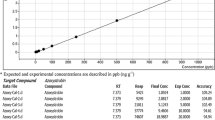Abstract
High-performance liquid chromatography is the prevalent method used to estimate Camptothecin quantitatively. In the present study thin layer chromatography and UV spectrophotometric method was established as a sensitive, economical and accurate method of detection and estimation of Camptothecin. The method was developed on TLC aluminum plates (60F254 from E-Merck Ltd.) precoated with silica gel using solvent system ethyl acetate: methanol (7.5:2.5, v/v) which gives a dark blue spot of Camptothecin at 254 nm (Rf value 0.46 cm). Spectrometric analysis of Camptothecin was carried out at the absorbance of 254 nm. Leaves and stems of Nothapodytes foetida and Ophiorrhiza mungos were extracted, subjected to TLC and UV spectrophotometric analysis and maximum absorption of CPT in ethyl acetate was observed at 254 nm. The quantification by this method was comparable to data obtained by HPLC. The optimized method was simple, repeatable, precise and cost effective, useful when there is large number of crude samples. In the present study this method was used to screen high yielding lines of CPT producing plants.






Similar content being viewed by others
Abbreviations
- CPT:
-
Camptothecin
- TLC:
-
Thin layer chromatography
- HPLC:
-
High performance liquid chromatography
References
Ahmed F, Vyas V, Saleem A, Li XG, Zamek R, Cornfield A, Haluska P, Ibrahim N, Rubin EH, Gupta E (1998) High-performance liquid chromatographic quantitation of total and lactone 20(S) camptothecin in patients receiving oral 20(S) camptothecin. J Chromatogram B: Biomed Sci Appl 707:227–233
Aimi N, Nishimura M, Miwa A, Hoshino H, Sakai S, Haginiwa J (1989) Pumiloside and deoxypumiloside, plausible intermediates of camoptothecin biosynthesis. Tetrahedron Lett 30:4991–4994
Arisawa M, Gunasekera SP, Cordell GA, Farnsworth NR (1981) Plant anticancer agents XXI. Constituents of Merrilliodendron megacarpum. Plant Med 43:404–407
Dighe V, Parekh G, Mestry D (2012) Quantitation of camptothecin from Ervatamia Heyneana (Wall.) T. cooke stem powder using high performance thin layer chromatography. Int J Pharm Bio Sci 3(3):230–237
Fulzele DP, Satdive RK (2005) Comparision of technique for the extraction of the anti-cancer drug camptothecin from Nothapodytes foetida. J Chromatogr A 1063(1–2):9–13
Fulzele DP, Satdive RK, Pol BB (2001) Growth and production of camptothecin by cell suspension culture of Nothapodytes foetida. Plant Med 67:150–152
Govindachari TR, Viswanathan N (1972) Alkaloids of Mappia foetida. Phytochemistry 11:3529–3531
Hsiang YH, Hertzberg R, Hecht, Liu LF (1985) Camptothecin induces protein-linked DNA breaks via mammalian DNA topoisomerase I. J Biol Chem 260:14873–14878
Kelland LR (2000) Flavopiridol, the first cyclin-dependent kinase inhibitor to enter the clinic: current status. Expert Opin Invest Drugs 9:2903–2911
Martin KP, Zhang C-L, Hembrom ME, Slater A, Madassery J (2008) Adventitious root induction in Ophiorrhiza prostrata, a tool for the production of CPT (an anticancer drug) and rapid propagation. Plant Biotechnol Rep 2(2):163–169. doi:10.1007/s11816-008-0057-4
Noble RL (1990) The discovery of the vinca alkaloids–chemotherapeutic agents against cancer. Biochem Cell Biol 68(12):1344–1351
Puri SC, Handa G, Gupta RK, Srivastava TN, Somal P, Sharma SN (1999) Quantitation of camptothecin in Nothapodytes foetida. J Indian Chem Soc 76:370–371
Rai VR (2002) Rapid clonal propagation of Nothapodytes foetida (Wight)-Sleumer a threatened Medicinal tree. In Vitro Cell Dev Biol—Plant 38:347–351
Rehm S, Devor DE (1993) Acute effects of 4-ipomeanol on experimental lung tumors with bronchiolar or alveolar cell features in Syrian hamsters or C3H/HeNCr mice. J Cancer Res Clin Oncol 120:41–50
Roja G, Heble MR (1994) The Quinoline alkaloids camptothecin and 9-methoxy camptothecin from tissue cultures and mature trees of Nothapodytes foetida. Phytochemistry 36:65–66
Sakato K, Tanaka H, Mukai N, Misawa M (1994) Isolation and identification of camptothecin from Camptotheca acuminate suspension cultures and mature trees of Nothapodytes foetida. Phytochemistry 36:65–66
Singh I, Kumaravadivel N, Gnanam R, Vellaikumar S (2009) RP-HPLC analysis of CPT content in Nothapodytes Nimmoniana an endangered medicinal plant. J Med Plant Res 4(3):255–259
Tafur S, Nelson JD, Delong DC, Svoboda GH (1976) Antiviral components of Ophiorrhiza mungos isolation of camptothecin and 10-methoxycamptothecin. Lloydia 39:261–262
Thurston LS, Imakura Y, Haruna M, Li DH, Liu ZC, Liu SY, Cheng YC, Lee KH (1989) Antitumour agents. 100. Inhibition of human DNA topoisomerase II by cytotoxic ether and ester derivatives of podophyllotoxin and.alpha.-peltatin. J Med Chem 32:604–608
Tsai TH, Tsai TR, Chen YF, Chou CJ, Chen CF (1999) Determination of unbound 20(S)-camptothecin in rat bile by on-line microdialysis coupled to microbore liquid chromatography with fluorescence detection. J Chromatogr B: Biomed Sci Appl 732(1):221–225
Van Hengel AJ, Harkes MP, Wichers HJ, Hesselink PG, Buitelaar RM (1992) Characterization of callus formation and camptothecin production by cell lines of Camptotheca acuminata. Plant Cell Tissue Organ Cult 28:11–18
Wall ME, Wani MC (1996) Camptothecin and taxol: from discovery to clinic. J Etnopharmacol 51:239–253
Yamazaki Y, Sudo H, Yamazaki M, Aimi N, Saito K (2003) Camptothecin biosynthetic genes in hairy roots of Ophiorrhiza pumila: cloning, characterization and differential expression in tissues and by stress compounds. Plant Cell Physiol 44(4):395–403
Zhao YX, Gao JQ, Qiao HL, Chen HL, Liang WQ (2006) Development and validation of a sensitive reversed-phase HPLC method to determine intracellular accumulation of hydroxycamptothecin. J Pharm Biomed Anal 41:1007–1010
Acknowledgements
The authors are thankful for the financial assistance provided by the National Medicinal Plants Board, New Delhi.
Author information
Authors and Affiliations
Corresponding author
Rights and permissions
About this article
Cite this article
Lokesh, P., Balasubramanya, S. & Anuradha, M. Cost effective quantification of camptothecin and a comparative study of its content in Nothapodytes foetida and Ophiorrhiza mungos sourced from selected geographical locations. Orient Pharm Exp Med 14, 87–92 (2014). https://doi.org/10.1007/s13596-013-0124-4
Received:
Accepted:
Published:
Issue Date:
DOI: https://doi.org/10.1007/s13596-013-0124-4




